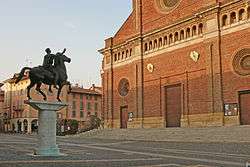Regisole

The Regisole ("Sun King") was a bronze classical or Late Antique equestrian monument, highly influential during the Italian Renaissance but destroyed in 1796. It was originally erected at Ravenna, in what is now Italy, but was moved to Pavia in the Middle Ages, where it stood on a column before the cathedral, as an emblem of communal pride and Pavia's deep connection with imperial Rome.[1]
History
According to different modern scholars the subject was either Theodoric the Great, King of the Ostrogoths (reigned 471–526),[2] "a Roman work of the third century AD",[2] or "possibly Septimius Severus, with several later modifications" (he was emperor 193–211).[3] Ravenna was the capital city of the Western Roman Empire from 402 until 476. It was later the capital of the Kingdom of the Ostrogoths and the Exarchate of Ravenna, the remaining Byzantine territory in northern Italy. The Colossus of Barletta is a standing Late Antique emperor in bronze that probably was also originally erected in Ravenna.
When, having been removed as a trophy of war to Milan, the Regisole was restored to Pavia in 1335, it was regilded and provided with up-to-date imperial trappings,[4] which may have included anachronistic harness and stirrups. Petrarch, who was aware that it had originally come from Ravenna, praised it in a letter to Boccaccio.[5] An impression of the Regisole, no doubt coloured by Renaissance ideals of decorum, is obtained from a woodcut illustration on the title page of the book of statutes of the city of Pavia, Statuta de Regimine Potestatis, civilia et criminalia Civitatis et Comitatus Papiae (Pavia, 1505).[6]
The Pavian bronze equestrian inspired 15th-century monuments such as the statues of the condottieri Gattamelata (which re-used the trick of adding a support under the raised leg of the horse, in this case a sphere instead of a dog) and Bartolomeo Colleoni.[7] Leonardo da Vinci's note recording his visit to Pavia in June 1490 is recorded on a sheet of the Codex Atlanticus; the Regisole prompted him to write "the imitation of antique works is more praiseworthy than modern ones". His celebrated but minute record of the Regisole is among his drawings in the Royal Collection.[8]
The historian Edward Gibbon, in passing through Pavia in May 1764, recorded details of the Regisole before its destruction: an equestrian statue of an emperor clad in chlamys and unarmed, leaning slightly forward and extending his arm in the attitude of an orator. The man was not bad, he thought, but the horse — which had inspired Leonardo — was "proud and beautiful". Without an inscription the monument was then being identified with Antoninus Pius, Constantine (whom the equestrian statue of Marcus Aurelius at Rome was long thought to represent) and Charles V, but Gibbon remarked that, unarmed and without a diadem, the latter two identifications were unlikely.[9] The surviving images show the front left leg of the horse raised up, with the hoof resting on, or held by, a dog standing on its hind legs.
After the French Revolution, the Regisole was destroyed by the Jacobin Club in Pavia in 1796, since it was considered a symbol of monarchy.[10]
In 1937 sculptor Francesco Messina was entrusted with the execution of a copy, according to ancient reproductions. The new Regisole, a 6-meter high bronze statue placed on a base of travertine, was relocated to the front of the Cathedral of Pavia and solemnly inaugurated on December 8, 1937.
| Wikimedia Commons has media related to Regisole. |
References
- ↑ Romano Soriga, "La tradizione romana di Pavia e la statua del Regisole", Atti e memorie del primo congresso storico lombardo (Como/Varese 1936; offprint, Milan 1937; G.Q. Giglioli, "Il regisole di Pavia", Bullettino del Museo dell'Impero Romano 2 (1940:57–66); G. Bovini, "Le Vicende del 'Regisole' statua equestre Ravennate," ''Felix Ravenna, 3rd ser. 35 (June 1963:138-54).
- 1 2 Walter A. Liedtke, The Royal Horse and Rider: painting, sculpture, and horsemanship, 1989:65
- ↑ Donald A. Bullough, Carolingian Renewal: sources and heritage, (1991:42).
- ↑ Noted in Roberto Weiss, The Renaissance Discovery of Classical Antiquity (Oxford: Blackwell) 1973:29.
- ↑ Petrarch, Rerum Senilium, v, 1, noted by Weiss 1973:35 and note.
- ↑ Illustrated, from the Houghton Library, Harvard, in Liedtke 1989, fig. 5.
- ↑ Bullough 1991:42.
- ↑ Carlo Pedretti, Leonardo da Vinci: drawings of horses and other animals (Windsor Castle. Royal Library) 1984.
- ↑ Gibbon's notebook jottings, in French, are quoted in Bullough 1991:74 note 15.
- ↑ R. Sòrige, "La tradizione romana in Pavia e la statua del Regisole", Atti e memorie del primo Congresso Storico Lombardo 1937; G. Bovini, "Le vicende del 'Regisole', statua equestre ravennate", Felix Ravenna third series, no. 36 (1963:138-54); R. Chevallier, "A propos du 'Regisole'", Felix Ravenna, third series, no. 46 (1968:21–25)..
Sources
- Saletti, Cesare (1997). Il Regisole di Pavia.
External links
- Paviaweb Reproductions of old images of the Regisole in the museum at Pavia.
